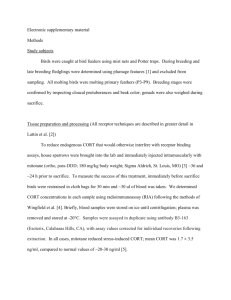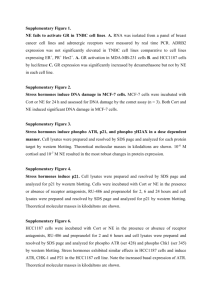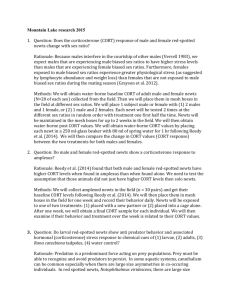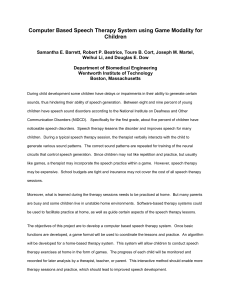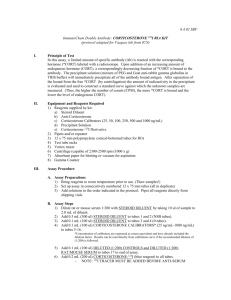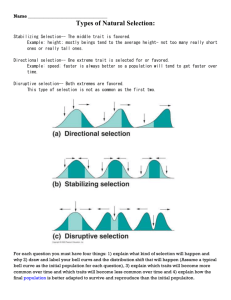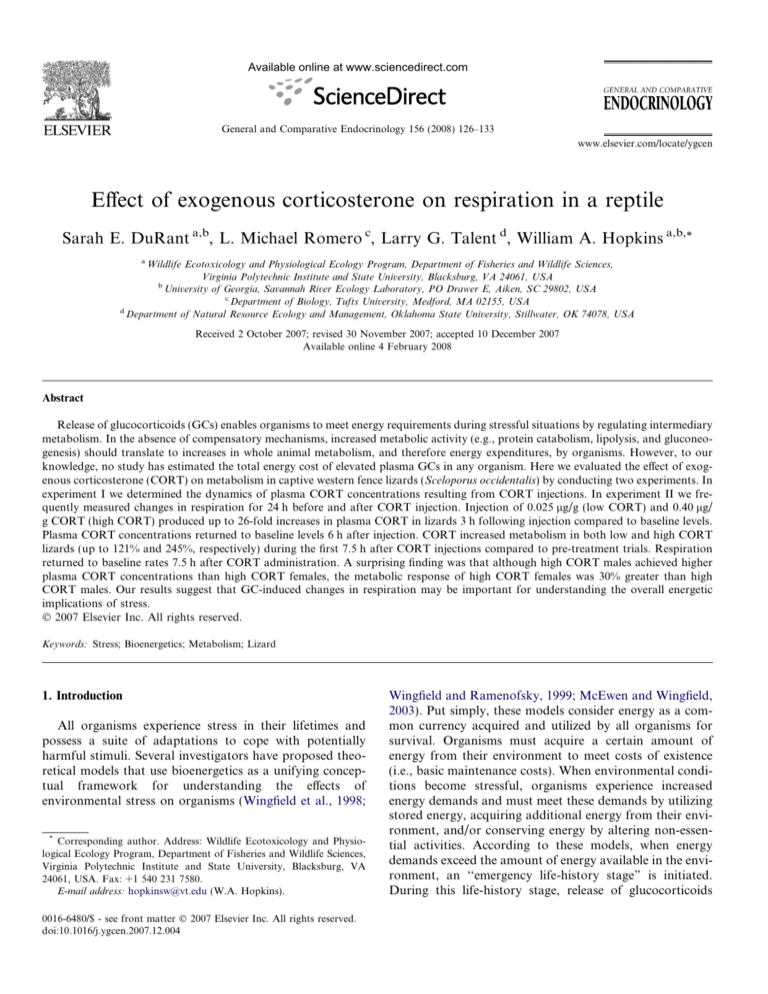
Available online at www.sciencedirect.com
General and Comparative Endocrinology 156 (2008) 126–133
www.elsevier.com/locate/ygcen
Effect of exogenous corticosterone on respiration in a reptile
Sarah E. DuRant a,b, L. Michael Romero c, Larry G. Talent d, William A. Hopkins a,b,*
a
Wildlife Ecotoxicology and Physiological Ecology Program, Department of Fisheries and Wildlife Sciences,
Virginia Polytechnic Institute and State University, Blacksburg, VA 24061, USA
b
University of Georgia, Savannah River Ecology Laboratory, PO Drawer E, Aiken, SC 29802, USA
c
Department of Biology, Tufts University, Medford, MA 02155, USA
d
Department of Natural Resource Ecology and Management, Oklahoma State University, Stillwater, OK 74078, USA
Received 2 October 2007; revised 30 November 2007; accepted 10 December 2007
Available online 4 February 2008
Abstract
Release of glucocorticoids (GCs) enables organisms to meet energy requirements during stressful situations by regulating intermediary
metabolism. In the absence of compensatory mechanisms, increased metabolic activity (e.g., protein catabolism, lipolysis, and gluconeogenesis) should translate to increases in whole animal metabolism, and therefore energy expenditures, by organisms. However, to our
knowledge, no study has estimated the total energy cost of elevated plasma GCs in any organism. Here we evaluated the effect of exogenous corticosterone (CORT) on metabolism in captive western fence lizards (Sceloporus occidentalis) by conducting two experiments. In
experiment I we determined the dynamics of plasma CORT concentrations resulting from CORT injections. In experiment II we frequently measured changes in respiration for 24 h before and after CORT injection. Injection of 0.025 lg/g (low CORT) and 0.40 lg/
g CORT (high CORT) produced up to 26-fold increases in plasma CORT in lizards 3 h following injection compared to baseline levels.
Plasma CORT concentrations returned to baseline levels 6 h after injection. CORT increased metabolism in both low and high CORT
lizards (up to 121% and 245%, respectively) during the first 7.5 h after CORT injections compared to pre-treatment trials. Respiration
returned to baseline rates 7.5 h after CORT administration. A surprising finding was that although high CORT males achieved higher
plasma CORT concentrations than high CORT females, the metabolic response of high CORT females was 30% greater than high
CORT males. Our results suggest that GC-induced changes in respiration may be important for understanding the overall energetic
implications of stress.
Ó 2007 Elsevier Inc. All rights reserved.
Keywords: Stress; Bioenergetics; Metabolism; Lizard
1. Introduction
All organisms experience stress in their lifetimes and
possess a suite of adaptations to cope with potentially
harmful stimuli. Several investigators have proposed theoretical models that use bioenergetics as a unifying conceptual framework for understanding the effects of
environmental stress on organisms (Wingfield et al., 1998;
*
Corresponding author. Address: Wildlife Ecotoxicology and Physiological Ecology Program, Department of Fisheries and Wildlife Sciences,
Virginia Polytechnic Institute and State University, Blacksburg, VA
24061, USA. Fax: +1 540 231 7580.
E-mail address: hopkinsw@vt.edu (W.A. Hopkins).
0016-6480/$ - see front matter Ó 2007 Elsevier Inc. All rights reserved.
doi:10.1016/j.ygcen.2007.12.004
Wingfield and Ramenofsky, 1999; McEwen and Wingfield,
2003). Put simply, these models consider energy as a common currency acquired and utilized by all organisms for
survival. Organisms must acquire a certain amount of
energy from their environment to meet costs of existence
(i.e., basic maintenance costs). When environmental conditions become stressful, organisms experience increased
energy demands and must meet these demands by utilizing
stored energy, acquiring additional energy from their environment, and/or conserving energy by altering non-essential activities. According to these models, when energy
demands exceed the amount of energy available in the environment, an ‘‘emergency life-history stage” is initiated.
During this life-history stage, release of glucocorticoids
S.E. DuRant et al. / General and Comparative Endocrinology 156 (2008) 126–133
(GCs) is one of the primary mechanisms used to reestablish
homeostasis.
Glucocorticoids have many effects in organisms, but one
of their primary roles is the regulation of intermediary
metabolism (i.e., sub-organismal metabolic processes
affecting energy storage and utilization; Dallman and
Bhatnagar, 2001). Release of GCs enables an organism to
meet energy requirements during times of need by promoting the conversion of proteins and lipids to carbohydrates
that are readily used by the organism (Mommsen et al.,
1999; Schreck, 1993). In the absence of compensatory
mechanisms to offset the additional costs of GC-induced
increases in metabolic activity (e.g., protein catabolism,
lipolysis, and gluconeogenesis), increases in intermediary
metabolism could translate to increases in whole animal
metabolism, and therefore energy expenditures, by organisms. Better understanding of the energy cost associated
with an increase in circulating GCs could provide valuable
insight into the ultimate costs of stress. However, relatively
few studies have examined the influence of GCs on whole
animal metabolism.
The studies that have examined the effect of GCs on
whole animal metabolism have focused on birds and fish,
and general consensus regarding the effect of GCs on metabolic rate remains unclear. Corticosterone (the primary
GC associated with stress in birds and reptiles; hereafter
CORT) increased metabolic rate in titmice (Parus major)
and black headed gulls (Larus ridibundus), had no effect
on metabolic rate in pigeons (Columba livia), and decreased
nocturnal metabolic expenditures in chickens (Gallus
domesticus), Gambel’s white-crowned sparrows (Zonotrichia leucophrys gambelii), and pine siskens (Carduelis pinus)
(Astheimer et al., 1992; Buttemer et al., 1991; Hissa et al.,
1980; Hissa and Palokangas, 1970; Mitchell et al., 1986;
Palokangas and Hissa, 1971). In fish, acute or chronic elevation in GCs generally results in increased metabolic rate
(Wendelaar Bonga, 1997), but limited evidence sometimes
supports (Barton and Schreck, 1987; Chan and Woo,
1978; DeBoeck et al., 2001; Morgan and Iwama, 1996)
and sometimes contradicts this contention (Davis and Schreck, 1977). Some of the discrepancies among studies may
be attributable to the use of pharmacological doses of
exogenous GCs in some studies (Hissa and Palokangas,
1970; Palokangas and Hissa, 1971) versus physiological
doses in other studies (Buttemer et al., 1991; Morgan and
Iwama, 1996; Davis and Schreck, 1977). Discrepancies
among studies may also relate to variations in procedures
employed to estimate metabolism. In many cases, metabolic rate was determined at a single discrete time (e.g.,
24 h after GCs were injected). However, changes in metabolism are dynamic and may not be captured with a discrete
metabolic measurement. Furthermore, a small change in
metabolism at a fixed point in time may not differ among
experimental groups, but if this difference is maintained
for extended periods of time, the total difference in energy
expended could be profound. To fully appreciate the
energy costs associated with stress, metabolic rate must
127
be monitored over extended time periods. To our knowledge, no study has estimated the total energy cost of elevated plasma GCs in any organism.
In this study we sought to determine whether acute
exposure to exogenous CORT increases whole animal respiration. To address this fundamental question we conducted two experiments to estimate the total energy cost
of elevated plasma GCs in western fence lizards (Sceloporus
occidentalis). In the first experiment we determined what
dose concentrations of exogenous CORT were necessary
to achieve physiological relevant plasma profiles. In the
second experiment, we monitored metabolic rate (i.e., oxygen consumption and carbon dioxide production) of male
and female lizards continually over a 24 h period after
exposure to one of two concentrations of CORT (0.025
and 0.40 lg/g). We hypothesized that exposure to exogenous CORT would result in dose-dependent increases in
plasma CORT and metabolism.
2. Materials and methods
2.1. Fence lizard natural history and husbandry
Sceloporus lizards belong to the family Phrynosomatidae which
accounts for more than 30% of all lizards in the United States. Some
Sceloporus serve as good study systems because their entire lifecycle is
manageable in the laboratory, and a great deal is known about their ecology, physiology, performance, and life-history (e.g., Garland et al., 1990;
Sinervo, 1990; Angilletta et al., 2002; Talent et al., 2002; Roe et al., 2005).
The species used in this study, S. occidentalis, ranges from Mexico to Canada between the California coast and western Utah, USA. The parental
stock originated from a population in the grasslands of the San Joaquin
Valley, CA, USA. Most females reach sexual maturity under ad libitum
feeding conditions in the laboratory within a year, and lay 3–6 clutches
of 8–15 eggs per year. This population of western fence lizards does especially well under laboratory conditions and has been identified as a good
candidate for use as a laboratory reptile model (Talent et al., 2002; Hopkins et al., 2005). Lizards from the San Joaquin Valley are also relatively
large bodied (up to 25 g) making repeated blood sampling possible without harming the animal.
Adult western fence lizards were shipped to The Savannah River Ecology Laboratory (SREL) from a breeding colony at Oklahoma State University. A total of 159 lizards were used in this study (respirometry: n = 96;
plasma CORT: n = 101). To reduce the number of lizards sacrificed during
our studies 38 lizards used during the respirometry experiment were also
used in the experiment to determine plasma CORT concentrations in lizards after CORT injection. Lizards used in both experiments were given at
least two weeks to recover from the respirometry experiment and then
were distributed among treatments in the plasma CORT experiment. Lizard husbandry was identical to Hopkins et al. (2005) with the following
exceptions: a 10:14 (light: dark) photoperiod, a daytime temperature gradient of 28–40 °C, and lizards were fed 4 crickets (1.5 cm each) a day
except on saturdays and sundays. Experimental procedures were approved
by the University of Georgia IACUC (A2004-10049-0).
2.2. Plasma CORT concentrations resulting from injections
To determine the dynamics of plasma concentrations of CORT resulting from our injections, we collected blood samples from lizards (n = 101),
pre-injection and 3, 6, and 12 h post-injection. Lizards were bled from the
post-orbital sinus using heparinized micro-capillary tubes. Each treatment
group consisted of 12–15 lizards per sex. Lizards were removed from their
cage, bled within 1–3 min, exposed to their assigned treatment (control,
vehicle, low CORT [0.025 lg/g] and high CORT [0.40 lg/g]) and then
S.E. DuRant et al. / General and Comparative Endocrinology 156 (2008) 126–133
returned to their cage. Lizards in the vehicle treatment were injected intraperitoneally with peanut oil while low CORT and high CORT lizards were
injected intraperitoneally with CORT (Sigma, C2505) dissolved in peanut
oil. Total injected volumes were always less than 160 lL. Capillary tubes
were stored on ice for no longer than 1.5 h before plasma was separated
using centrifugation. Plasma samples were then stored at 60 °C. Lizards
were fasted for 48 h prior to blood collection but had continual access to
water throughout the experiment. Because short periods between feeding
intervals (weekends) were commonly experienced by our lizards, a 48 h
fast was not a novel experience and should not have been stressful for
the animals.
O2 consumption (ml/hr)
128
Time (hrs)
2.3. Respirometry
To determine the energy cost associated with exposure to exogenous
CORT we followed methods similar to Hopkins et al. (2004) and Roe
et al. (2005). Each animal was subjected to two sequential respiratory trials, a pre-treatment trial and a post-treatment trial. A total of 32 samples
were collected over a 24 h period at 45 min intervals for each trial. The
pre-treatment trial was used to determine each lizard’s standard metabolic
rate (SMR), which served as a baseline for comparison to the post-treatment trial. The post-treatment trial was used to determine increases in
energy expenditure resulting from exposure to CORT. To ensure postabsorptivity, lizards were fasted for 48 h prior to collecting any respirometry measurements (Roe et al., 2005). At the end of fasting, each lizard was
weighed and transferred to a glass respiratory chamber (600 ml) for its
pre-treatment trial. Both oxygen consumption and carbon dioxide production were then continually monitored for a 24 h period by connecting each
chamber to a computer-controlled, closed circuit respirometer (Micro
Oxymax, Columbus Instruments). In this system both oxygen consumption (VO2 ) and carbon dioxide production (VCO2 ) are measured simultaneously. Incurrent air passed through columns of DrieriteÒ to absorb
water before passing into individual respirometry chambers. Air leaving
respirometry chambers was dried again using magnesium perchlorate
before passing into the oxygen sensor. Details of the respirometry system
are discussed elsewhere (Hopkins et al., 1999, 2004). After 24 h lizards
were removed from their chamber and then exposed to one of four treatments: control, vehicle, low CORT, or high CORT. Total injected volumes
were always less than 140 lL. After injection, lizards were immediately
returned to their chambers for post-treatment respirometry measurements.
The total time for the transition from pre- to post-treatment trials was 1–
3 min for each lizard. We measured metabolism in a total of 96 lizards,
sexes were divided evenly among treatment groups (N = 12 females and
12 males per treatment).
All trials were initiated between 08:00 and 09:10 h. Lizards were
housed in an environmental chamber held at 30 °C in total darkness
throughout respiratory measurements. Individual respiratory chambers
were also covered with paper to remove any external stimuli.
2.4. Respirometry calculations
From the respirometry data collected, SMR and post-treatment energetic expenditures were determined as follows. Because SMR is the metabolic rate of a resting, post-absorptive ectotherm at a specified
temperature during the inactive phase of its circadian cycle (Bennett and
Dawson, 1976), we removed peaks in respiration associated with activity
and circadian rhythms from the pre-treatment data to estimate SMR. To
accomplish this, SMR was estimated as the lowest quartile value of the
pre-treatment trial. Other studies on reptiles have been successful at estimating SMR values using similar methods (Hopkins et al., 2004; DuRant
et al., 2007). Once SMR was estimated, we then estimated the volume of gas
exchanged that was required to support SMR as the integral of SMR
(Fig. 1). In addition to estimating SMR requirements, we also estimated
the total volume of O2 consumed and CO2 produced (VO2 and VCO2 , respectively) over the entire 24 h trial. Total VO2 and VCO2 were estimated as the
integral (i.e., area under the curve) of respiration. VO2 and VCO2 above
SMR (additional VO2 and VCO2 ; energy allocated towards supporting circa-
Fig. 1. A graphical representation of respiration components calculated
for each lizard. SMR (dotted line) was estimated as the lowest quartile
value of oxygen consumption rates. The integral of SMR (dotted region)
represents oxygen consumed to support basic maintenance costs. The area
above SMR (hatched region) represents oxygen consumed to support
spontaneous activity, circadian rhythms, or increases in respiration
attributable to corticosterone. Identical techniques were used to determine
changes in carbon dioxide production.
dian rhythms, spontaneous activity, and costs associated with elevated
CORT) were estimated by subtracting the integral of SMR (from the
pre-treatment trial) from total VO2 and VCO2 (from the post-treatment trial;
Fig. 1). In statistical analyses we compared additional VO2 and VCO2 over
the first 7.5 h of the pre- and post-treatment respirometry trials because this
corresponded to the time in which plasma CORT concentrations were elevated (see Section 3). Using additional VO2 and VCO2 instead of total VO2
and VCO2 for analyses accounts for inter-individual variability in SMR.
2.5. Radioimmunoassay
Corticosterone was assayed by radioimmunoassay (RIA) following the
methods of Wingfield et al. (1992). Briefly, samples were exposed to redistilled dichloromethane to extract CORT and then resuspended in phosphate buffer. Samples were compared to a standard curve, which
contained known amounts of CORT, run with each assay. Small amounts
of tritiated CORT were added to each sample to determine CORT recovery and the recovery was used to adjust final concentrations. Inter- and
intra-assay variation were 15% and 6%, respectively, as determined by
running a plasma standard in each assay.
2.6. Statistical analyses
For each statistical test, all data were log10 transformed prior to analyses to better achieve normal distribution and equal variance (Ryan-Joiners and Bartlett’s test, respectively). All three and four-way interaction
terms were included in initial models, however interactions with p > 0.10
were dropped from subsequent iterations. Metabolic parameters examined
were not independent of one another, therefore we applied a sequential
Bonferroni adjustment to account for multiple, non-independent comparisons and to maintain an experiment wide a of 0.05.
We conducted a repeated measures ANOVA (SAS proc mixed) to
investigate the influence of CORT injection on circulating CORT plasma
levels. In the model we considered treatment and sex as independent variables and time as the repeated variable.
We conducted two ANCOVAs (SAS proc mixed) to determine whether
SMR (O2 and CO2) differed between treatment groups during the pretreatment trial. In the model treatment and sex were considered independent variables with log10 mass as the covariate to control for the influence
of body size on respiration (Andrews and Pough, 1985).
To examine the influence of CORT injections on additional VO2 and
VCO2 during the first 7.5 h of the post-treatment trial compared to the
pre-treatment trial, we conducted two repeated measures ANCOVA’s
S.E. DuRant et al. / General and Comparative Endocrinology 156 (2008) 126–133
using a mixed model approach (SAS proc mixed). In the model we considered treatment and sex as independent variables, time as the repeated variable, and log10 transformed mass as the covariate.
3. Results
Both the low CORT and high CORT lizards had elevated plasma CORT concentrations 3 h after injection
(treatment time: p = <0.001; Table 1, Fig. 2). The interaction between sex and time also had a significant effect on
plasma CORT concentrations of lizards (p = 0.010) with
males exhibiting higher plasma CORT levels than females.
Simple effects tests (LSMEANS/SLICE) were implemented
to dissect significant two-way interactions and revealed
that before injection there was no treatment time interaction or sex time interaction (for both variables p > 0.53).
However, 3 h after injection there was a strong treatment time interaction (F = 9.72, p < 0.001) but no sex time interaction (p = 0.14). Six hours post-injection
CORT concentrations no longer differed among treatments
(treatment time p = 0.42). However, there was a marginal sex time interaction (p = 0.06) at 6 h post-injection
which appeared to be driven by a slight elevation in plasma
CORT concentrations of male control and vehicle lizards
but not from females from the same groups. CORT levels
returned to near-baseline levels 12 h post-injection and no
Table 1
Results of repeated measures ANOVA for the effects of CORT injection
on circulating CORT plasma concentrations in Sceloporus occidentalis
pre- and 3, 6, and 12 h post-injection
Variable
Effect
Num df
F
p
Plasma CORT (ng/ml)
Trt
Sex
Time
Trt Sex
Trt Time
Time Sex
3
1
3
3
9
3
2.93
0.29
60.21
.82
2.99
3.57
0.0414*
0.6037
<0.0001*
0.6282
<0.0001*
0.0101*
An * denotes a significant effect based on an a of 0.05. The mixed procedure was performed using SAS. Sample size = 12–15 males and females
for each treatment.
Controls: N = 12 females, 13 males; Vehicle: N = 12 females, 12 males;
0.025 lg/g: N = 15 females, 12 males; 0.04 lg/g N = 13 females, 12 males.
plasma CORT (ng/ml)
Sexes Combined
longer differed among treatments or between sexes (treatment time p = 0.75; sex time p = 0.15).
Examination of the respirometry data revealed that lizards exhibited circadian fluctuations in respiration
(Fig. 3). Respiration peaked in the afternoon, dropped to
baseline over night, and then began to rise again the next
day just prior to trial termination. These same circadian
rhythms have recently been documented in lizards from
the same population as the lizards used in our experiment
(Roe et al., 2005). However, CORT-induced changes in respiration were easily distinguishable from respiration
changes caused by diel activity patterns. SMR estimates
for each individual transected the baseline respiration values observed overnight and were not influenced by diel
activity patterns. After applying a Bonferroni sequential
adjustment, we found that there was no effect of sex, treatment, or their interaction on SMR during the pre-treatment trial (O2 and CO2; p > 0.0390; adjusted a = 0.025;
Table 2).
When we examined the effects of exogenous CORT on
additional VO2 and VCO2 we found that lizards had higher
gas exchange rates in the post-treatment trial than pretreatment trials (Figs. 3 and 4) but this was dependent
upon treatment (time treatment: p < 0.001 for both
gases; Table 3), and sex (p < 0.001 for both gases). Males
and females exposed to high CORT consumed 164% and
250% more O2, respectively, during the post-treatment trial
compared to the pre-treatment trial (Figs. 3 and 4). Similarly high CORT male and female lizards produced 157%
and 245% more CO2, respectively, after treatment with
CORT. Low CORT males consumed 100% more O2 and
produced 121% more CO2 during the post-treatment trial
than in the pre-treatment trial, whereas low CORT females
only consumed 14% more O2 and produced 9% more CO2
during the post-treatment trial.
4. Discussion
The results of our study indicate that increases in plasma
CORT do indeed increase whole-animal metabolism. We
found that injection with CORT caused a dose-dependent
increase in circulating CORT concentrations in lizard
Females
Males
80
80
60
60
40
40
40
20
20
20
80
controls
vehicle
0.025ug/g
0.400ug/g
*
60
0
0
0
3
6
9
12
129
0
0
3
6
9
12
0
3
6
9
12
Time (hrs)
Fig. 2. Plasma corticosterone concentrations (ng/ml) of Sceloporus occidentalis before injection, and +3, +6, and +12 h after injection with varying
concentrations of corticosterone. Error bars are ±1 standard error of the mean. N = 12–17 lizards per sex per treatment group for each time point. On the
graph with sexes combined an * denotes when significant time treatment effects were detected in post hoc analyses of the overall statistical model.
130
S.E. DuRant et al. / General and Comparative Endocrinology 156 (2008) 126–133
4
4
Controls: Sexes combined
pre treatment
post treatment
SMR
3
2
2
2
1
1
1
0
0
4
5
10
15
20
0
0
25
4
0.025 µg/g: Sexes combined
5
10
15
20
25
0
4
0.025 µg/g: Females
3
3
3
2
2
2
1
1
1
0
0
0
4
5
10
15
20
4
0.40 µg/g: Sexes combined
5
10
15
20
25
4
0.40 µg/g: Females
3
3
2
2
2
1
1
1
5
10
15
20
25
15
20
25
5
10
15
20
25
0.40 µg/g: Males
0
0
0
10
0.025 µg/g: Males
0
3
0
5
0
0
25
Controls: Males
3
3
0
Oxygen Consumption Rate (ml/hr)
4
Controls: Females
0
5
10
15
20
25
0
5
10
15
20
25
Time (hrs)
Fig. 3. Oxygen consumption rates (ml/h) of Sceloporus occidentalis before (open circles) and after (closed circles) injection with corticosterone. Dashed
lines indicate the average SMR of lizards during the pre-treatment respirometry trial. Error bars are ±1 standard error of the mean. N = 12 lizards per sex
per treatment group for both pre- and post-treatment trials.
plasma (Fig. 2). Concomitantly, energy expenditure
increased in a dose-dependent manner after CORT injection (Figs. 3 and 4). Although males and females in each
treatment group received the same dose of CORT, they
responded differently to CORT injection both in plasma
CORT levels and metabolic responsiveness. Whereas males
appeared to achieve higher plasma CORT concentrations,
females had a greater metabolic response.
Importantly, plasma CORT concentrations of lizards in
our study were physiologically relevant, falling within the
range of plasma CORT concentrations of wild S. occidentalis under baseline and stressed conditions. Plasma CORT
concentrations of lizards, both males and females, did not
differ prior to CORT injections (3.0 ± 0.5 ng/ml) and were
comparable to baseline plasma CORT concentrations of
wild S. occidentalis (3–18 ng/ml; Dunlap, 1995; Dunlap
and Schall, 1995; Dunlap and Wingfield, 1995). Increases
in plasma CORT concentrations peaked 3 h post-injection
and were significantly elevated compared to baseline con-
centrations (6- to 26-fold increases; Fig. 2) at this time.
However, these effects were transient, with plasma CORT
concentrations returning to near-baseline levels within 6 h
of injection. The transient peak in CORT exhibited by
our CORT treated animals is probably similar to that elicited by many types of acute stress. For example, Great Tits
exposed to a simulated predator exhibited patterns of
plasma CORT concentrations over time (Cockrem and
Silverin, 2002) similar to those exhibited by our lizards
after CORT injection. Our highest CORT concentration
(0.40 lg/g) induced plasma CORT levels (48.9 ± 8.6 ng/
ml) comparable to some of the highest plasma CORT concentrations noted in stressed wild S. occidentalis (60 ng/
ml; Dunlap, 1995; Dunlap and Schall, 1995; Dunlap and
Wingfield, 1995) and our lowest CORT concentration
achieved plasma CORT concentrations (24.5 ± 4.3 ng/ml)
that were well within that range. Although males and females
in the highest treatment group received the same dose of
CORT, males achieved plasma CORT concentrations that
S.E. DuRant et al. / General and Comparative Endocrinology 156 (2008) 126–133
Table 2
Results of ANCOVA examining differences in SMR of Sceloporus
occidentalis (log10 mass as a covariate) among treatment groups during
the pre-treatment respirometry trial
Variable
Effect
Num
df
Den
df
F
P
SMR
(ml O2 h 1)
Trt
Sex
Trt sex
log10 mass trt
log10 mass sex
log10
mass trt sex
log10 mass
3
1
3
3
1
3
80
80
80
80
80
80
2.55
0.03
2.32
2.66
0.05
2.39
0.0617
0.8581
0.0820
0.0538
0.8248
0.0745
1
80
2.27
0.1359
3
1
3
3
1
3
80
80
80
80
80
80
2.72
0.07
2.87
2.82
0.04
2.92
0.0501
0.7850
0.0416
0.0442
0.8340
0.0390
1
80
2.27
0.1354
SMR
(ml
CO2 h 1)
Trt
Sex
Trt sex
log10 mass trt
log10 mass sex
log10
mass trt sex
log10 mass
After applying a sequential Bonferroni adjustment to maintain an experimental wide a of 0.05 there was no effect of treatment, sex, or their
interactions. The mixed procedure was performed using SAS. Sample
size = 12 for each treatment for each sex for all variables.
12.0
Table 3
Results of repeated measures ANCOVA for the effects of exogenous
CORT exposure on oxygen consumed and carbon dioxide produced above
standard maintenance costs (log10 mass as a covariate) in Sceloporus
occidentalis pre- and post-CORT injection
Variable
Effect
Num df
Den df
F
p
VO2 (ml)
Trt
Sex
Time
Trt time
Trt sex
Sex time
Trt sex time
log10 mass
log10 mass sex
3
1
1
3
3
1
3
1
1
86
86
88
88
86
88
88
86
86
1.62
14.31
22.84
10.73
2.25
1.11
2.41
1.09
13.25
0.1916
0.0003*
<0.0001*
<0.0001*
0.0879
0.2960
0.0722
0.2983
0.0005*
VCO2 (ml)
Trt
Sex
Time
Trt time
Trt sex
Sex time
Trt sex time
log10 mass
log10 mass sex
3
1
1
3
3
1
3
1
1
86
86
88
88
86
88
88
86
86
1.30
13.56
31.71
9.56
2.70
0.00
2.50
0.23
12.59
0.2785
0.0004*
<0.0001*
<0.0001*
0.0509
0.9965
0.0650
0.6296
0.0006*
An * denotes effects that were significant after application of a sequential
Bonferroni adjustment. The mixed procedure was performed using SAS.
Sample size = 12 for each treatment for each sex for all variables.
pre treatment
Sexes combined
12.0
post treatment
10.0
10.0
*
*
6.0
6.0
4.0
4.0
2.0
2.0
0.0
0.0
12.0
Females
10.0
8.0
6.0
4.0
2.0
0.0
12.0
Males
10.0
8.0
6.0
4.0
2.0
0.0
12.0
10.0
8.0
8.0
6.0
6.0
4.0
4.0
2.0
2.0
control
*
12.0
10.0
0.0
*
8.0
Volume of CO2 Produced (ml)
Volume of O 2 Consumed (ml)
8.0
131
vehicle 0.025µg/g 0.400µg/g
Treatment
0.0
control
vehicle 0.025µg/g 0.400µg/g
Treatment
Fig. 4. Patterns of oxygen consumption (ml) and carbon dioxide production (ml) among western fence lizards (Sceloporus occidentalis) acutely exposed to
varying concentrations of corticosterone. Oxygen consumed and carbon dioxide produced that was greater than maintenance costs (additional VO2 and
VCO2 ) over a 7.5 h period before and after CORT injection. Data are presented as means ± 1SE. On the graphs with sexes combined an * denotes for which
treatments a significant treatment time interaction was detected in post hoc analyses of the overall statistical model.
132
S.E. DuRant et al. / General and Comparative Endocrinology 156 (2008) 126–133
were twice as great as females (males: 66.6 ± 14.8 ng/ml;
females: 32.5 ± 7.0 ng/ml; Fig. 2).
Similar to plasma CORT concentrations, respiration
quickly increased in response to CORT injections, by
1.8 h after injection. Increases in respiration were also transient and returned to pre-injection levels approximately
7.5 h after injection (Fig. 3). While there was a clear
dose-dependent metabolic response to plasma CORT concentrations in males, an increase in metabolism in females
was only evident in high CORT females. However, the lack
of dose-responsiveness in females may in part be attributable to outliers in our sample population. Three females
in the vehicle and low CORT groups expended 40–151%
more energy in pre-treatment trials than all other female
lizards, perhaps obfuscating detection of elevated energy
use post-treatment. In fact if the low CORT female with
unusually high energy expenditure (151% greater) is eliminated from the data set, oxygen consumption increases in
this group by 30% during the post-treatment trial compared to the pre-treatment trial.
A surprising result from our study is the difference in
responses of males and females exposed to the highest
CORT concentration. Although high CORT males
achieved 105% higher plasma CORT concentrations than
high CORT females, the metabolic response of these
females was 30% greater than high CORT males (Figs. 3
and 4). These differences may be attributable to differences
in the genetics or the internal milieu of males and females.
For instance, there are differences in circulating testosterone (T) between males and females. Increases in testosterone have been shown to decrease CORT clearance rate
by increasing plasma concentrations of binding proteins
or increasing the plasma’s binding capacity for CORT
(Daniel and Assenmacher, 1974; Silverin, 1986; Klukowski
et al., 1997; Jennings et al., 2000). If such sex-specific differences in the metabolic clearance of CORT occurred, it
could also explain the lessened metabolic response in males
because much of the CORT would have been bound in the
plasma making less CORT available to bind to receptors.
Although CORT-induced increases in respiration were
relatively brief (6–8 h) in both male and female lizards,
when converted to energy equivalents (1 ml O2 consumed = 19.8 J; Secor and Diamond, 1995) these increases
represented a significant energy cost. Energy consumption
in low CORT males and females increased by 14–100%
and increased by 164–245% in high CORT males and
females, respectively, following administration of CORT.
This energy expense is equivalent to 3–11% of daily
requirements to support SMR (SMR: 0.51–0.52 kJ) for
low CORT male and female lizards and 17–27% for high
CORT male and female lizards. Repeated and prolonged
periods of elevated energy expenditure due to repeated
acute or chronic stress could ultimately result in energetic
trade-offs that have severe consequences for an individual.
For example, in many reptiles, approximately 80% of their
energy budget is comprised of maintenance costs whereas
only 20% is allocated towards production of new tissue
(Congdon et al., 1982, 2001). Therefore small increases in
maintenance costs could result in proportionally large
decreases in energy available for production.
In summary, our study represents the most comprehensive assessment of the effects of acute increases in CORT on
energy expenditure to date. We demonstrated that physiologically relevant increases in CORT cause substantial
increases in respiration. This is important because novel
stressors are implicated as major factors contributing to
population declines in vertebrates, including reptiles and
amphibians (Gibbons et al., 2000; Stuart et al., 2004).
Understanding the energetic impact of the stress response
on vertebrates could provide insight into the consequences
of stressors on traits which could ultimately translate into
population-level effects (e.g., reproduction). Furthermore,
our work provides support for the idea that energy deficits
generated by stressors, resulting in the onset of an ‘‘emergency life-history stage”, may be quantifiable and can
provide a unifying framework for studying stress
ecophysiology.
Acknowledgments
We would like to thank Nicole Cyr, Molly Dickens,
Chris Hayes, Ryan Holem, and Justin Jones for technical
assistance. Ignacio Moore and Anne McNabb reviewed
earlier drafts of the manuscript. Animal husbandry was
in conformance with all appropriate animal care and use
protocols. Financial support was provided by US Department of Energy through the Financial Assistance Award #
DE-FC09-96SR18546 to the University of Georgia Research Foundation, and teaching and research assistantships from the Department of Fisheries and Wildlife
Sciences at Virginia Polytechnic Institute and State University and from the Savannah River Ecology Laboratory
Graduate Program. Partial funding was provided through
an award by the Long Range Research Initiative of the
American Chemistry Council to Oklahoma State University and from National Science Foundation Grants IOB0542099 and IBN-0235044 to L.M.R.
References
Andrews, R.M., Pough, F.H., 1985. Metabolism of squamate reptiles:
allometric and ecological relationships. Physiol. Zool. 58, 214–231.
Angilletta, M.J., Hill, T., Robson, M.A., 2002. Is physiological performance optimized by thermoregulatory behavior?: a case study of the
eastern fence lizard, Sceloporus undulatus. J. Therm. Biol. 27, 199–204.
Astheimer, L.B., Buttemer, W.A., Wingfield, J.C., 1992. Interactions of
corticosterone wit feeding, activity, and metabolism in passerine birds.
Ornis Scand. 23, 355–365.
Barton, B.A., Schreck, C.B., 1987. Metabolic cost of acute physical stress
in juvenile steelhead. Trans. Am. Fish. Soc. 116, 257–263.
Bennett, A.F., Dawson, W.R., 1976. Metabolism. In: Gans, C. (Ed.),
Biology of the Reptilia: Physiology A, vol. 5. Academic Press, New
York, pp. 127–223.
Buttemer, W.A., Astheimer, L.B., Wingfield, J.C., 1991. The effect of
corticosterone on standard metabolic rates of small passerine birds. J.
Comp. Physiol. B 161, 427–431.
S.E. DuRant et al. / General and Comparative Endocrinology 156 (2008) 126–133
Cockrem, J.F., Silverin, B., 2002. Sight of a predator can stimulate a
corticosterone response in the Great Tit (Parus major). Gen. Comp.
Endocrinol. 125, 248–255.
Congdon, J.D., Dunham, A.E., Tinkle, D.W., 1982. Energy budgets and
life histories of reptiles. In: Gans, C. (Ed.), Biology of Reptilia, vol. 13.
Academic Press, New York, pp. 233–271.
Congdon, J.D., Dunham, A.E., Hopkins, W.A., Rowe, C.L., Hinton,
T.G., 2001. Resource allocation-based life histories: a conceptual basis
for studies of ecological toxicology. Environ. Toxicol. Chem. 20, 1698–
1703.
Chan, D.K.O., Woo, N.Y.S., 1978. Effect of cortisol on the metabolism of
the eel, Anguilla japonica. Gen. Comp. Endocrinol. 35, 205–215.
Dallman, M.F., Bhatnagar, S., 2001. Chronic stress and energy balance:
role of the hypo-thalamo-pituitary axis. In: McEwen, B.S., Goodman,
H.M. (Eds.), Handbook of Physiology Section 7: The Endocrine
System, Coping with the Environment: Neural and Endocrine Mechanisms, vol. 4. Oxford University Press, New York, pp. 179–210.
Daniel, J.Y., Assenmacher, I., 1974. Hormonal effects on plasma binding
capacity in ducks. J. Steroid Biochem. 5, 399.
Davis, L.E., Schreck, C.B., 1977. The energetic response to handling stress
in juvenile Coho salmon. Trans. Am. Fish. Soc. 126, 248–258.
DeBoeck, G., Aslop, D., Wood, C., 2001. Cortisol effects on aerobic and
anaerobic metabolism, nitrogen excretion, and whole-body composition in juvenile rainbow trout. Physiol. Biochem. Zool. 74, 858–868.
Dunlap, K.D., 1995. Hormonal and behavioral responses to food and
water deprivation in a lizard (Sceloporus occidentalis): implications for
assessing stress in a natural population. J. Herpetol. 29, 345–351.
Dunlap, K.D., Schall, J.J., 1995. Hormonal alterations and reproductive
inhibition in male fence lizards (Sceloporus occidentalis) infected with the
malarial parasite Plasmodium mexicanum. Physiol. Zool. 64, 608–621.
Dunlap, K.D., Wingfield, J.C., 1995. External and internal influences on
indices of physiological stress. I. Seasonal and population variation in
adrenocortical secretion of free-living lizards, Sceloporus occidentalis.
J. Exp. Zool. 271, 36–46.
DuRant, S.E., Hopkins, W.A., Talent, L.G., 2007. Energy acquisition and
allocation in an ectothermic predator exposed to a common environmental stressor. Comp. Biochem. Physiol. 145C, 442–448.
Garland, T., Hankins, E., Huey, R.B., 1990. Locomotor capacity and
social dominance in male lizards. Funct. Ecol. 4, 243–250.
Gibbons, J.W., Scott, D.E., Ryan, T.J., Buhlmann, K.A., Tuberville,
T.D., Metts, B.S., Greene, J.L., Mills, T., Leiden, Y., Poppy, S.,
Winne, C.T., 2000. The global decline of reptiles, deja vu amphibians.
Bioscience 50, 653–666.
Hissa, R., George, J.C., Saarela, S., 1980. Dose-related effects of
noradrenaline and corticosterone on temperature regulation in the
pigeon. Comp. Biochem. Physiol. 65C, 25–32.
Hissa, R., Palokangas, R., 1970. Thermoregulation in the titmouse (Parus
major L.). Comp. Biochem. Physiol. 33, 941–953.
Hopkins, W.A., Rowe, C.L., Congdon, J.D., 1999. Elevated trace element
concentrations and standard metabolic rate in banded water snakes
(Nerodia fasciata) exposed to coal combustion wastes. Environ.
Toxicol. Chem. 18, 1258–1263.
Hopkins, W.A., Roe, J.H., Phillipi, T., Congdon, J.D., 2004. Standard
and digestive metabolism in the banded water snake, Nerodia fasciata
fasciata. Comp. Biochem. Physiol. 137A, 141–149.
Hopkins, W.A., Staub, B.P., Baionno, J.A., Jackson, B.P., Talent, L.G.,
2005. Transfer of selenium from prey to predators in a simulated
terrestrial food chain. Environ. Pollut. 134, 447–456.
133
Jennings, D.H., Moore, M.C., Knapp, R., Matthews, L., Orchinik, M.,
2000. Plasma steroid-binding globulin mediation of differences in stress
reactivity in alternative male phenotypes in tree lizards, Urosaurus
ornatus. Gen. Comp. Endocrinol. 120, 289–299.
Klukowski, L.A., Cawthorn, J.M., Ketterson, E.D., Nolan Jr., V., 1997.
Effects of experimentally elevated testosterone on plasma corticosterone and corticosteroid-binding globulin in dark-eyed juncos (Junco
hyemalis). Gen. Comp. Endocrinol. 108, 141–151.
McEwen, B.S., Wingfield, J.C., 2003. The concept of allostasis in biology
and biomedicine. Horm. Behav. 43, 2–15.
Mitchell, M.A., MacLeod, M.G., Raza, A., 1986. The effects of ACTH
and dexamethasone upon plasma thyroid hormone levels and heat
production in the domestic fowl. Comp. Biochem. Physiol. 85A, 207–
215.
Mommsen, T.P., Vijayan, M.M., Moon, T.W., 1999. Cortisol in teleosts:
dynamics, mechanisms of action and metabolic regulation. Rev. Fish
Biol. Fish. 9, 211–268.
Morgan, J.D., Iwama, G.K., 1996. Cortisol-induced changes in
oxygen consumption and ionic regulation in coastal cutthroat
trout (Oncorhynchus clarki clarki) parr. Fish Physiol. Biochem. 15,
385–394.
Palokangas, R., Hissa, R., 1971. Thermoregulation in young black-headed
full (Larus ridibundus). Comp. Biochem. Physiol. 38A, 743–750.
Roe, J.H., Hopkins, W.A., Talent, L.G., 2005. Effects of body mass,
feeding, and circadian cycles on metabolism in the lizard Sceloporus
occidentalis. J. Herpetol. 39, 595–603.
Schreck, C.B., 1993. Glucocorticoids: metabolism, growth and development. In: Schriebman, M.P., Scanes, C.G., Pang, P.K.T. (Eds.), The
Endocrinology of Growth, Development, and Metabolism in Vertebrates. Academic Press, London, pp. 367–392.
Secor, S.M., Diamond, J., 1995. Adaptive responses to feeding in Burmese
pythons pay before pumping. J. Exp. Biol. 198, 1313–1325.
Silverin, B., 1986. Corticosterone-binding proteins and behavioral effects
of high plasma levels of corticosterone during the breeding period in
the pied flycatcher. Gen. Comp. Endocrinol. 64, 67–74.
Sinervo, B., 1990. Evolution of thermal physiology and growth rate
between populations of the western fence lizard (Sceloporus occidentalis). Oecologia 83, 228–237.
Stuart, S.N., Chanson, J.S., Cox, N.A., Young, B.E., Rodrigues, A.S.L.,
Fischman, D.L., Waller, R.W., 2004. Status and trends of amphibian
declines and extinctions worldwide. Science 306, 1783–1786.
Talent, L.G., Dumont, J.N., Bantle, J.A., Janz, D.M., Talent, S.G., 2002.
Evaluation of western fence lizards (Sceloporus occidentalis) and
eastern fence lizards (Sceloporus undulatus) as laboratory reptile
models for toxicological investigations. Environ. Toxicol. Chem. 21,
899–905.
Wendelaar Bonga, S.E., 1997. The stress response in fish. Physiol. Rev. 77,
591–625.
Wingfield, J.C., Maney, D.L., Breuner, C.W., Jacobs, J.D., Lynn, S.,
Ramenofsky, M., 1998. Ecological bases of hormone-behavior
interaction: the emergency life history stage. Am. Zool. 38, 191–
206.
Wingfield, J.C., Ramenofsky, M., 1999. Hormones and the behavioral
ecology of stress. In: Balm, P.H. (Ed.), Stress Physiology in Animals.
Sheffield Academic Press, Sheffield, pp. 1–51.
Wingfield, J.C., Vleck, V.M., Moore, M.C., 1992. Seasonal-changes of the
adrenocortical-response to stress in birds of the Sonoran desert. J. Exp.
Zool. 264, 419–428.

